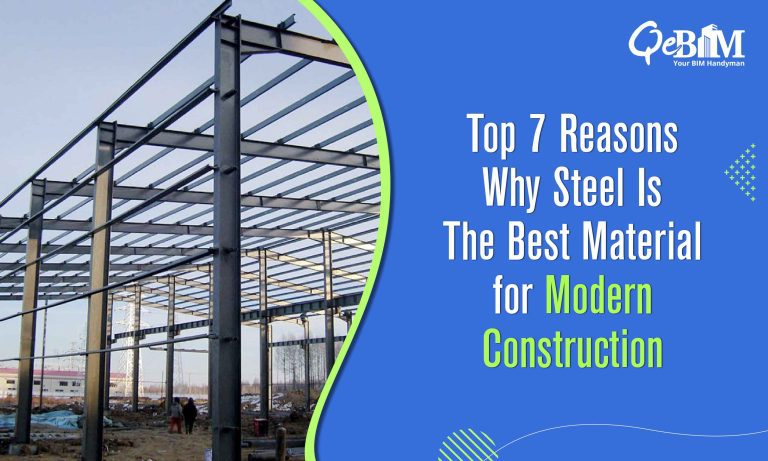Top 7 Reasons Why Steel Is the Best Material for Modern Construction

In the dynamic world of modern construction, innovation and efficiency are the key. Architects, engineers and builders continually seek materials that offers strength, flexibility, sustainability along with the cost-effectiveness. Among the variety of building materials available today, steel has emerged as the material of choice for modern construction and that too for all the good reasons.
From soaring skyscrapers and long-span bridges to the green buildings and resilient infrastructures, steel forms the backbone of countless modern structures. But exactly what makes the steel so indispensable?
Let’s explore the compelling reasons with facts and figures as to why steel is the go-to material in today’s construction world.
1) Unmatched Strength-to-Weight Ratio
Steel’s strength-to-weight ratio outperforms many traditional building materials including the wood and concrete.
- Structural steel has a yield strength of around 250 MPa to 550 MPa depending on the grade tehreby making it five to ten times stronger than the concrete in tension.
- Despite being strong, steel is up to 60% lighter than wood or concrete for the same structure hence reducing the foundation loads as well as the material handling costs.
This high strength enables the construction of the taller buildings with fewer materials—key to modern urban development. These advantages are often maximized through the Structural BIM Services which helps to optimize the design and performance of the steel frameworks during the planning stage.
2) Speed and Efficiency in Construction
Time is money in construction and steel delivers the speed.
- According to the World Steel Association, steel buildings can be erected 20%–30% faster than those built with the concrete.
- Prefabrication off-site reduces the weather delays and enhances the precision with up to 90% of a steel structure’s work completed before it arrives at the site.
This makes steel a clear winner for the large-scale projects, modular buildings and the one with tight deadlines. Accurate Steel Detailing Services are essential to ensure the seamless assembly, minimize reworks as well as to improve the project timelines.
3) Sustainability and Environmental Benefits
Steel is a champion of the circular economy principles.
- It is 100% recyclable and over 98% of structural steel is recovered and recycled at the end of a building’s life.
- Around 40% of the global steel production comes from scrap recycling thereby minimizing the environmental impact.
- The Embodied Carbon of steel has been steadily decreasing due to the innovations like electric arc furnace (EAF) technology and also the greener supply chains.
Steel buildings also offer better insulation hence enabling the energy-efficient performance and contributing towards the LEED certification or BREEAM ratings.
4) Durability and Resistance
Steel’s resilience makes it ideal for the long-lasting structures.
- Properly coated steel can last 50+ years without significant corrosion or degradation.
- Fire-rated structural steel can withstand temperatures of up to 1,100°F (593°C) for up to 4 hours giving it a crucial evacuation and response time.
- Steel-framed buildings are also 30% more earthquake-resistant than conventional concrete frames due to the steel’s flexibility.
This durability reduces the lifecycle maintenance and ensures the reliability in the extreme environments right from the coastlines to the seismic zones.
5) Design Versatility and Aesthetic Appeal
Modern steel fabrication allows the intricate and futuristic designs.
- Steel can be bent into curves, shaped into the lattices or even used in the long spans of up to 18–30 meters without any intermediate support.
- This has enabled the creation of icons like the Burj Khalifa, The Shard and Beijing National Stadium—all showcasing the steel’s aesthetic as well as the structural possibilities.
Steel also complements the materials like glass, concrete and stone hence making it a favourite for the architects who seek both beauty and function.
6) Cost-Effectiveness in the Long Run
While the initial steel prices fluctuate with the global demand, the long-term value is quite solid.
- Studies by the Steel Construction Institute (SCI) shows that the steel-framed buildings can have a 10%–15% lower total cost of ownership over the span of 30 years as compared to the traditional concrete alternatives.
- Faster construction reduces the labor and equipment rental costs too.
- Lower maintenance and higher durability translates to 30%–50% savings on the lifecycle repair and the retrofit costs.
Steel also adds salvage value: old structural steel components can be resold or reused thereby adding the financial returns even at the end of a building’s life.
7) Adaptability and Expansion
Modern buildings are rarely static and steel keeps the pace.
- Steel-framed structures can be reconfigured with the minimal downtime, with components removed, replaced or even extended easily.
- This is especially valuable in the sectors like healthcare, education and commercial real estate where the floor plan changes or even the vertical expansions are often needed.
A prime example: London’s Canary Wharf development uses the modular steel frames to support the phased construction and future vertical expansion without even interrupting the existing tenants.
Conclusion
Steel is not just a construction material, it is a strategic enabler of the modern architecture and infrastructure. With its high strength, fast build times, eco-friendly lifecycle, design flexibility as well as the long-term value, steel stands at the forefront of the 21st-century construction.
In an age where cities are rising, climate change demands the sustainable solutions and efficiency is everything, steel tends to deliver.
Bottom line? Steel builds the future and builds it quite better.